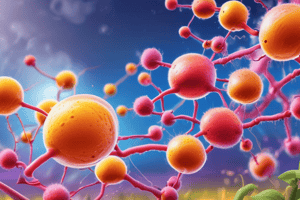Podcast
Questions and Answers
Ποιο από τα παρακάτω είναι το σημαντικότερο σημείο ελέγχου για τη ρύθμιση της γλυκολυτικής οδού;
Ποιο από τα παρακάτω είναι το σημαντικότερο σημείο ελέγχου για τη ρύθμιση της γλυκολυτικής οδού;
- Η πυροσταφυλική αφυδρογονάση
- Η φωσφογλυκερική κινάση
- Η εξοκινάση
- Η φωσφοφρουκτοκινάση (PFK) (correct)
Ποιο ένζυμο ελέγχει την ποσότητα ακετυλο-CoA που εισέρχεται στον κύκλο του κιτρικού οξέος;
Ποιο ένζυμο ελέγχει την ποσότητα ακετυλο-CoA που εισέρχεται στον κύκλο του κιτρικού οξέος;
- Η ισοκιτρική αφυδρογονάση
- Η πυροσταφυλική αφυδρογονάση (correct)
- Η α-κετογλουταρική αφυδρογονάση
- Η κιτρική συνθάση
Ποια από τις παρακάτω ρυθμιστικές μορφές παρέχουν σήματα για την ενεργειακή κατάσταση του κυττάρου στην πυροσταφυλική αφυδρογονάση;
Ποια από τις παρακάτω ρυθμιστικές μορφές παρέχουν σήματα για την ενεργειακή κατάσταση του κυττάρου στην πυροσταφυλική αφυδρογονάση;
- ATP, ADP, σουκκινυλο-CoA, κιτρικό οξύ
- ATP, NADH, πυροσταφυλικό, ακετυλο-CoA
- ADP, NADH, α-κετογλουταρικό, ισοκιτρικό
- ATP, ADP, NADH, σουκκινυλο-CoA (correct)
Ποια από τις παρακάτω αντιδράσεις ελέγχεται από την ισοκιτρική αφυδρογονάση και την α-κετογλουταρική αφυδρογονάση;
Ποια από τις παρακάτω αντιδράσεις ελέγχεται από την ισοκιτρική αφυδρογονάση και την α-κετογλουταρική αφυδρογονάση;
Εκτός από τους άμεσους μηχανισμούς ρύθμισης, ποιος άλλος μηχανισμός μπορεί να επηρεάσει τους ρυθμούς της γλυκόλυσης;
Εκτός από τους άμεσους μηχανισμούς ρύθμισης, ποιος άλλος μηχανισμός μπορεί να επηρεάσει τους ρυθμούς της γλυκόλυσης;
Flashcards are hidden until you start studying
Study Notes
Glycolysis and Pyruvate Oxidation
Glycolysis and pyruvate oxidation are crucial processes in cellular respiration, allowing cells to generate energy from glucose. Glycolysis is the process of breaking down glucose into two pyruvate molecules, generating ATP and NADH. Pyruvate oxidation then converts these pyruvates into acetyl CoA, which enters the citric acid cycle (also known as the Krebs cycle) for further energy production. Both glycolysis and pyruvate oxidation are subject to regulation to ensure efficient use of resources based on a cell's energy requirements.
Glycolysis
Glycolysis is a fundamental process that splits glucose into two pyruvate molecules. It occurs in both aerobic and anaerobic conditions, with the former leading to pyruvate entering the citric acid cycle for oxidative phosphorylation. The regulation of glycolysis primarily focuses on the third step catalyzed by phosphofructokinase (PFK). PFK is inhibited by ATP and activated by adenosine monophosphate (AMP), which indicates low energy levels and high energy deficiency, respectively. Additionally, PFK can be inhibited by citrate, signaling the presence of a backup of citric acid cycle products.
Pyruvate Oxidation
Pyruvate oxidation is the conversion of pyruvate to acetyl CoA in the mitochondrial matrix or cytoplasm, depending on whether the organism is eukaryotic or prokaryotic. The enzyme complex responsible for this reaction, known as pyruvate dehydrogenase, consists of three interconnected enzymes and over 60 subunits. This complex controls the amount of acetyl CoA fuel entering the citric acid cycle. Like other cellular respiration enzymes, pyruvate dehydrogenase is regulated through binding at allosteric sites by molecules such as ATP, ADP, NADH, and succinyl CoA. These regulatory molecules provide signals about the cell's energy state, allowing for feedback control.
Pyruvate oxidation also regulates the entry into the citric acid cycle. Two steps in the cycle are subject to regulation: isocitrate dehydrogenase, controlling the production of isocitrate from α-ketoglutarate; and α-ketoglutarate dehydrogenase, responsible for turning the five-carbon compound from the previous step into a four-carbon compound bound to CoA (succinyl CoA). These enzymes are sensitive to changes in the cell's energy status, ensuring efficient use of resources.
Glycolytic Pathway Regulation
Several steps within glycolysis are regulated, but the most significant control point is the third step catalyzed by phosphofructokinase (PFK). This regulation helps maintain overall control of the glycolysis pathway. In addition to these direct regulatory mechanisms, transcriptional control can also influence glycolytic rates through alterations in the concentration of key enzymes in response to hormonal status changes.
In summary, glycolysis and pyruvate oxidation play vital roles in cellular respiration, allowing cells to generate energy from glucose. These processes are subject to various layers of regulation, ensuring that they operate efficiently based on a cell's energy requirements.
Studying That Suits You
Use AI to generate personalized quizzes and flashcards to suit your learning preferences.




